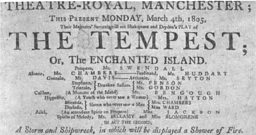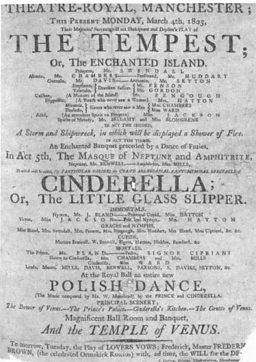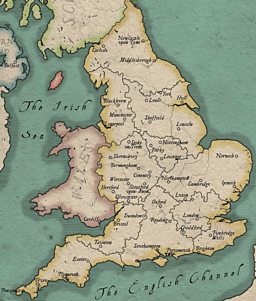The Tempest adapted in Manchester
A Storm and Shipwreck, in which will be displayed a Shower of Fire
This version of The Tempest has a wonderful detail of a scene. But it wasn’t the version that theatre-goers today might expect to see.
In 1667 The Tempest was heavily cut and adapted by the dramatists Davenant and John Dryden. It became The Tempest or The Enchanted Island.
-
![]()
Much ado near me
Hear more Shakespeare stories on BBC Radio Manchester
-
![]()
Shakespeare Festival 2016
The BBC celebrates the genius of the bard

The first woman to perform Shakespeare
In Shakespeare’s original The Tempest there is only one female role - Miranda.
In the Restoration new characters were introduced and the number of female roles expanded reflecting a new phenomenon - the actress.
But in the Restoration new characters were introduced and the number of female roles expanded reflecting a new phenomenon - the actress.
These additions were only made possible by a ground-breaking production of Othello, which, for the first time, featured a female Desdemona. It took place in a theatre, newly converted from a tennis court.
Experts have pieced together her identity - as it was unrecorded at the time - and deduced that the first woman to perform Shakespeare was called Ann Quinn.
Thomas Jordan, wrote a prologue in which he drew attention to this novelty:
"I come, uknown to any of the rest.
To tell the news; I saw the lady drest--
The woman plays to-day; mistake me not,
No man in gown or page in petticoat."
In this version Miranda has a sister, named Dorinda; and Caliban also has a sister, named Sycorax.
Prospero has a foster-son, Hippolito, who has never set eyes on a woman.
Hippolito was a “breeches part”, where thrillingly for the spectators, a woman is required to dress as a man. At a time when women wore full-length gowns, it is difficult to underestimate the allure of a shapely leg and well-turned ankle on a theatre audience!
The choice of this play at this particular period in Manchester’s history is interesting too. With its emphasis on monarchy as the natural form of government and royalist ideals it could be seen as preserving the established social hierarchy. Chances were that the audience included members of the emerging middle and working classes as the city was expanding rapidly with the growth of the cotton industry.
Social upheaval and radical agitation were on the agenda.
This rising population, many of whom lived in poverty and deprivation, created challenges. In the 1790s Police Commissioners were introduced with responsibility for the night watch as well as roads, street cleaning, street lighting and the maintenance of fire engines. But day to day governance was run along medieval lines with a Borough reeve with responsibility for law and order.
Food riots erupted in 1797, soup kitchens were set up two years later and by the end of the century the textile trade was suffering its first serious recession.
Social upheaval and radical agitation were on the agenda.
This playbill is dated from 1805. Does the choice of play reflect a desire for law and order as the city enters a volatile period in its history?
The full playbill

About Shakespeare on Tour
From the moment they were written through to the present day, Shakespeare’s plays have continued to enthral and inspire audiences. They’ve been performed in venues big and small – including inns, private houses and emerging provincial theatres.

BBC English Regions is building a digital picture which tracks some of the many iconic moments across the country as we follow the ‘explosion’ in the performance of The Bard’s plays, from his own lifetime to recent times.
Drawing on fascinating new research from Records of Early English Drama (REED), plus the British Library's extensive collection of playbills, as well as expertise from De Montfort University and the Arts and Humanities Research Council, Shakespeare on Tour is a unique timeline of iconic moments of those performances, starting with his own troupe of actors, to highlights from more recent times. Listen out for stories on Shakespeare’s legacy on your BBC Local Radio station from Monday 21 March, 2016.
You never know - you might find evidence of Shakespeare’s footsteps close to home…
Craig Henderson, BBC English Regions

-
![]()
Shakespeare Lives
The nation’s greatest performing arts institutions mark 400 years since the Bard's death
Related Links

Shakespeare on Tour: Around Manchester
-
![]()
Manchester gets a Theatre Royal
Manchester finally got its own Theatre Royal by royal patent in 1775
-
![]()
Child acting sensation Master Betty on stage in Manchester
Master Betty plays Macbeth in Manchester
-
![]()
Small Cheshire town attracts Shakespeare's players
Shakespeare's Players often visited Congleton
Shakespeare on Tour: Around the country
-
![]()
Ipswich: a magnet for Shakespeare?
Why did Shakespeare's company visit Ipswich ten times?
-
![]()
Sarah Siddons visits Norwich
Putting the Theatre Royal, Norwich, on the map
-
![]()
Madame Tussaud's exhibiton in Nottingham
Including a model of William Shakespeare
-
![]()
Touring Kent to avoid the plague
In 1592, the plague forced touring theatre companies out of London










